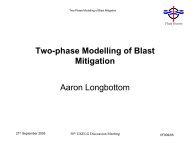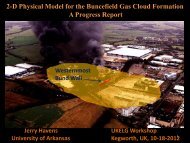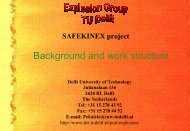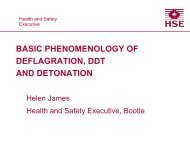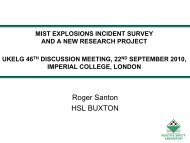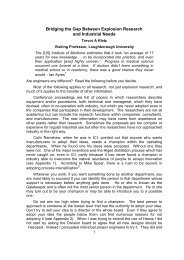Validation of dispersion simulations using PDR-FOAM - ukelg
Validation of dispersion simulations using PDR-FOAM - ukelg
Validation of dispersion simulations using PDR-FOAM - ukelg
Create successful ePaper yourself
Turn your PDF publications into a flip-book with our unique Google optimized e-Paper software.
GAS DISPERSION WITH OPEN<strong>FOAM</strong><br />
Chris Dixon<br />
Major Hazards Management Centre <strong>of</strong> Expertise<br />
Copyright <strong>of</strong> Shell Research Ltd<br />
October 2012<br />
1
DEFINITIONS AND CAUTIONARY NOTE<br />
Resources: Our use <strong>of</strong> the term “resources” in this announcement includes quantities <strong>of</strong> oil and gas not yet classified as Securities and Exchange Commission <strong>of</strong> the United States<br />
("SEC") proved oil and gas reserves or SEC proven mining reserves. Resources are consistent with the Society <strong>of</strong> Petroleum Engineers 2P and 2C definitions.<br />
The companies in which Royal Dutch Shell plc directly and indirectly owns investments are separate entities. In this announcement "Shell", "Shell Group" and "Royal Dutch Shell" are<br />
sometimes used for convenience where references are made to Royal Dutch Shell plc and its subsidiaries in general. Likewise, the words "we", "us" and "our" are also used to refer to<br />
subsidiaries in general or to those who work for them. These expressions are also used where no useful purpose is served by identifying the particular company or companies.<br />
"Subsidiaries", "Shell subsidiaries" and "Shell companies" as used in this announcement refer to companies in which Shell either directly or indirectly has control, by having either a<br />
majority <strong>of</strong> the voting rights or the right to exercise a controlling influence. The companies in which Shell has significant influence but not control are referred to as "associated<br />
companies" or "associates" and companies in which Shell has joint control are referred to as "jointly controlled entities". In this announcement, associates and jointly controlled entities<br />
are also referred to as "equity-accounted investments". The term "Shell interest" is used for convenience to indicate the direct and/or indirect (for example, through our 23 per cent.<br />
shareholding in Woodside Petroleum Ltd.) ownership interest held by Shell in a venture, partnership or company, after exclusion <strong>of</strong> all third-party interest.<br />
This announcement contains forward looking statements concerning the financial condition, results <strong>of</strong> operations and businesses <strong>of</strong> Shell and the Shell Group. All statements other than<br />
statements <strong>of</strong> historical fact are, or may be deemed to be, forward-looking statements. Forward-looking statements are statements <strong>of</strong> future expectations that are based on<br />
management's current expectations and assumptions and involve known and unknown risks and uncertainties that could cause actual results, performance or events to differ materially<br />
from those expressed or implied in these statements. Forward-looking statements include, among other things, statements concerning the potential exposure <strong>of</strong> Shell and the Shell<br />
Group to market risks and statements expressing management’s expectations, beliefs, estimates, forecasts, projections and assumptions. These forward looking statements are<br />
identified by their use <strong>of</strong> terms and phrases such as "anticipate", "believe", "could", "estimate", "expect", "goals", "intend", "may", "objectives", "outlook", "plan", "probably",<br />
"project", "risks", "seek", "should", "target", "will" and similar terms and phrases. There are a number <strong>of</strong> factors that could affect the future operations <strong>of</strong> Shell and the Shell Group<br />
and could cause those results to differ materially from those expressed in the forward looking statements included in this announcement, including (without limitation): (a) price<br />
fluctuations in crude oil and natural gas; (b) changes in demand for Shell's products; (c) currency fluctuations; (d) drilling and production results; (e) reserves estimates; (f) loss <strong>of</strong><br />
market share and industry competition; (g) environmental and physical risks; (h) risks associated with the identification <strong>of</strong> suitable potential acquisition properties and targets, and<br />
successful negotiation and completion <strong>of</strong> such transactions; (i) the risk <strong>of</strong> doing business in developing countries and countries subject to international sanctions; (j) legislative, fiscal<br />
and regulatory developments including regulatory measures addressing climate change; (k) economic and financial market conditions in various countries and regions; (l) political<br />
risks, including the risks <strong>of</strong> expropriation and renegotiation <strong>of</strong> the terms <strong>of</strong> contracts with governmental entities, delays or advancements in the approval <strong>of</strong> projects and delays in the<br />
reimbursement for shared costs; and (m) changes in trading conditions. All forward looking statements contained in this announcement are expressly qualified in their entirety by the<br />
cautionary statements contained or referred to in this section. Readers should not place undue reliance on forward looking statements. Additional factors that may affect future results<br />
are contained in Shell's 20-F for the year ended 31 December 2011 (available at www.shell.com/investor and www.sec.gov ). These factors also should be considered by the reader.<br />
Each forward looking statement speaks only as <strong>of</strong> the date <strong>of</strong> this announcement, 22 February 2012. Neither Shell nor any <strong>of</strong> its subsidiaries nor the Shell Group undertake any<br />
obligation to publicly update or revise any forward looking statement as a result <strong>of</strong> new information, future events or other information. In light <strong>of</strong> these risks, results could differ<br />
materially from those stated, implied or inferred from the forward looking statements contained in this announcement.<br />
Shell may have used certain terms, such as resources, in this announcement that the SEC strictly prohibits Shell from including in its filings with the SEC. U.S. investors are urged to<br />
consider closely the disclosure in Shell's Form 20-F, File No 1-32575, available on the SEC website www.sec.gov. You can also obtain these forms from the SEC by calling 1-800-<br />
SEC-0330.<br />
Copyright <strong>of</strong> Shell Research Ltd 2
AGENDA<br />
Introduction/Motivation<br />
Open<strong>FOAM</strong><br />
Solver<br />
<strong>Validation</strong><br />
Test Case<br />
Conclusions<br />
Copyright <strong>of</strong> Shell Research Ltd<br />
October 2012 3
1.0<br />
INTRODUCTION<br />
The need for a large number <strong>of</strong> CFD <strong>dispersion</strong> calculations.<br />
Copyright <strong>of</strong> Shell Research Ltd<br />
October 2012 4
DESIGN OVERPRESSURE<br />
Understanding explosion overpressure is important in the design <strong>of</strong><br />
onshore and <strong>of</strong>fshore plant; for example blast walls, protection <strong>of</strong><br />
Emergency Shut Down Valves etc.<br />
The assessment <strong>of</strong> explosion hazards due to accidental releases <strong>of</strong><br />
flammable gas <strong>of</strong>ten requires the quantification <strong>of</strong> the likely gas cloud<br />
sizes produced by a range <strong>of</strong> potential leak scenarios and wind<br />
conditions.<br />
There is a need to consider a range <strong>of</strong> scenarios because, although<br />
the simplest approach in assessing explosion hazards is to calculate a<br />
“worst-case” explosion, a genuine worst case is an event <strong>of</strong> extremely<br />
low probability.<br />
Copyright <strong>of</strong> Shell Research Ltd<br />
October 2012 5
EXCEEDANCE CURVES<br />
Results normally presented as exceedance curves:<br />
←Overpressure exceedance<br />
Gas cloud size exceedance →<br />
Copyright <strong>of</strong> Shell Research Ltd October 2012 6
LEAK SCENARIOS<br />
An individual release scenario is typically specified by a number <strong>of</strong><br />
parameters such as:<br />
The released material and its conditions (pressure and temperature).<br />
The location and orientation and the size <strong>of</strong> the leak.<br />
The wind speed and direction.<br />
These parameters are not chosen arbitrarily:<br />
Each leak is associated with some item <strong>of</strong> equipment, the frequency <strong>of</strong><br />
leaks <strong>of</strong> differing sizes is found by a “parts count” which supplies the<br />
number <strong>of</strong> items <strong>of</strong> various types – valves, flanges etc. – and historical<br />
data on failure rates for these items.<br />
The wind speed and direction are chosen from a probability<br />
distribution characterised by the wind rose for the location.<br />
Copyright <strong>of</strong> Shell Research Ltd<br />
October 2012 7
THE MAIN PROBLEM<br />
Have two desires:<br />
Would like to do enough gas <strong>dispersion</strong> calculations to properly<br />
characterise the gas build-up exceedance curve.<br />
Would like each calculation to be accurate.<br />
These two desires pull in opposite directions:<br />
Using a Monte Carlo approach, over a thousand <strong>dispersion</strong><br />
calculations may be required.<br />
CFD calculations have, historically, been too slow to allow this.<br />
Copyright <strong>of</strong> Shell Research Ltd<br />
October 2012 8
PREVIOUSLY...<br />
The Shell methodology has historically emphasised the<br />
Monte Carlo aspect <strong>of</strong> the problem.<br />
Model <strong>dispersion</strong> <strong>using</strong> particle based “random walk”<br />
model.<br />
Particle velocity =<br />
30<br />
velocity due to jet release momentum+<br />
background flow velocity +<br />
semi-random turbulent component<br />
Calculate trajectories <strong>of</strong> 1000s <strong>of</strong> independent<br />
particles and determine gas concentration<br />
Assume fixed background flow field calculated from<br />
CFD.<br />
20<br />
10<br />
0<br />
-10<br />
-20<br />
-20 -10 0 10 20 30 40<br />
Concentration<br />
0.15<br />
0.1<br />
0.05<br />
0<br />
Copyright <strong>of</strong> Shell Research Ltd<br />
October 2012<br />
9
2.0<br />
OPEN<strong>FOAM</strong> CFD SOLVER(S)<br />
A steady-state <strong>PDR</strong> solver with sub-grid jet source.<br />
Copyright <strong>of</strong> Shell Research Ltd<br />
October 2012 10
OPEN<strong>FOAM</strong> (1)<br />
Open source CFD code.<br />
<strong>FOAM</strong> = Field Operation and Manipulation.<br />
Originates from Imperial College.<br />
Around since ~1998.<br />
Available to download.<br />
Support contracts available from OpenCFD.<br />
Training available from various suppliers.<br />
Really “multiphysics”, but seems to have moved to CFD.<br />
Use C++ features to allow solvers to be constructed writing equations<br />
as they are written.<br />
Copyright <strong>of</strong> Shell Research Ltd<br />
October 2012<br />
11
OPEN<strong>FOAM</strong> (2)<br />
Adopted as platform for next-generation explosion CFD code within<br />
Shell Major Hazards Group to replace existing in-house code.<br />
A Porosity/Distributed Resistance solver (<strong>PDR</strong>Foam) is part <strong>of</strong> the<br />
standard distribution. Development was funded by Shell.<br />
Open<strong>FOAM</strong> chosen because:<br />
Modern architecture.<br />
Inbuilt Parallelism.<br />
Arbitrary meshing.<br />
Flexible & extensible.<br />
Safe against vendor changes.<br />
Copyright <strong>of</strong> Shell Research Ltd<br />
October 2012 12
SOLVER OVERVIEW<br />
Basis:<br />
Compressible SIMPLE-based solver.<br />
Uses Porosity/Distributed Resistance method (if needed).<br />
Arbitrary mesh.<br />
Additional species equation.<br />
Tabulated thermodynamics.<br />
Sub-grid release model.<br />
Note:<br />
Transient <strong>PDR</strong> solver is part <strong>of</strong> standard Open<strong>FOAM</strong> distribution<br />
(<strong>PDR</strong>Foam).<br />
Solver used here is not <strong>PDR</strong>Foam, but a steady-state version. Aim is to<br />
get “reasonable” <strong>dispersion</strong> results with short run-time.<br />
Copyright <strong>of</strong> Shell Research Ltd<br />
October 2012 13
POROSITY/DISTRIBUTED RESISTANCE<br />
Convert geometry to cell-wise values <strong>of</strong>:<br />
Volume porosity<br />
Average diameter <strong>of</strong> obstacles in cell<br />
Obstacle surface area per unit volume<br />
(Tensor) drag<br />
Turbulence generation<br />
Drag on log-scale.<br />
(NB Small obstacles omitted in picture)<br />
Copyright <strong>of</strong> Shell Research Ltd<br />
October 2012<br />
14
THEMODYMAMICS<br />
Solver accepts tables, but these produced externally (by any method).<br />
In this case <strong>using</strong> Shell in-house thermodynamics code.<br />
Modified Redlich-Kwong.<br />
Accounts for condensation/evaporation <strong>of</strong> ambient water.<br />
Single species equation (no requirement for water vapour equation etc.)<br />
Copyright <strong>of</strong> Shell Research Ltd October 2012 15
3.0<br />
VALIDATION<br />
Testing the solver against experimental data.<br />
Copyright <strong>of</strong> Shell Research Ltd<br />
October 2012<br />
16
FULL-SCALE: JIP RIG<br />
← Physical rig<br />
CAD representation→<br />
Copyright <strong>of</strong> Shell Research Ltd October 2012 17
EXPERIMENTAL ARRANGEMENT<br />
Series A & B<br />
Series C<br />
Copyright <strong>of</strong> Shell Research Ltd October 2012 18
RESULTS: FLAMMABLE GAS VOLUME<br />
Experimental gas cloud volume found from number <strong>of</strong> measurement<br />
locations with concentration above lower flammable limit.<br />
CFD results are improvement on previous methodology – less outliers.<br />
Copyright <strong>of</strong> Shell Research Ltd October 2012 19
RESULTS: CASES WHERE DICE AND CFD DIFFER<br />
Some cases where DICE gives poor results:<br />
Case C05: obstacle omitted.<br />
Case A28: flow reversed.<br />
Copyright <strong>of</strong> Shell Research Ltd October 2012 20
CASE C05 CFD RESULTS<br />
Concentration on 4 planes at 1, 3, 5 and 7 m above ground.<br />
CFD results shown by contours, experiment by spheres on same scale.<br />
Spheres placed at measurement locations.<br />
Copyright <strong>of</strong> Shell Research Ltd October 2012 21
RESULTS: CASES WHERE CFD IS POOR<br />
Some cases where CFD gives poor results are:<br />
For A2, A22, A24 CFD under-predicts.<br />
For A8 CFD over-predicts.<br />
Copyright <strong>of</strong> Shell Research Ltd October 2012 22
CASE A02 CFD RESULTS (OPEN<strong>FOAM</strong> UNDER-PREDICTS)<br />
Concentration on vertical plane though release.<br />
CFD results shown by contours, experiment by spheres on same scale.<br />
Spheres placed at measurement locations.<br />
Black point shows release location.<br />
Results actually quite reasonable.<br />
Copyright <strong>of</strong> Shell Research Ltd October 2012 23
CASE A17 CFD RESULTS (OPEN<strong>FOAM</strong> OVER-PREDICTS)<br />
Locations with concentration above 2.5%.<br />
CFD results shown by isosurface (right).<br />
Spheres placed at measurement locations (left).<br />
Cloud shape is reasonable.<br />
Experiment has large volume a little below LFL, CFD a little above.<br />
Copyright <strong>of</strong> Shell Research Ltd October 2012 24
SUB-GRID JET MODEL<br />
↑<br />
Free choked methane jet<br />
Full scale methane jet in cross-flow →<br />
Copyright <strong>of</strong> Shell Research Ltd<br />
October 2012<br />
25
SUB-GRID JET MODEL – FLASHING CASE (CO2)<br />
Horizontal liquid CO2 release at 150 bar.<br />
←Concentration vs. distance<br />
Temperature vs. distance →<br />
Copyright <strong>of</strong> Shell Research Ltd October 2012 26
SAMPLE EXCEEDANCE CURVE<br />
Use JIP rig geometry.<br />
Use wind rose from a previous project.<br />
Assume some plant items in 10 distinct 2 m cubes within the rig.<br />
Assume that each item has 25 and 50 mm releases.<br />
Assume some leak frequencies.<br />
Discretize wind into 8 directions (N, NE, etc). For each leak scenario<br />
do at least two releases for each wind direction – one in lower half <strong>of</strong><br />
wind speed probability distribution one in lower half.<br />
Leak direction is random. Leak location random within cube.<br />
Number <strong>of</strong> repeats for each leak scenario depends on leak rate and<br />
frequency.<br />
Copyright <strong>of</strong> Shell Research Ltd<br />
October 2012<br />
27
SAMPLE EXCEEDANCE CURVE<br />
A typical resulting exceedance curve is shown below.<br />
Copyright <strong>of</strong> Shell Research Ltd October 2012 28
SAMPLE EXCEEDANCE CURVE<br />
A typical resulting exceedance curve is shown below.<br />
Copyright <strong>of</strong> Shell Research Ltd October 2012 29
SUMMARY<br />
Open<strong>FOAM</strong> can provide a reasonable platform for gas <strong>dispersion</strong> CFD:<br />
<strong>PDR</strong> and resolved regions can be mixed and matched.<br />
<strong>PDR</strong> regions can be locally refined.<br />
Flexible, extensible...<br />
Generally gas cloud exceedance calculations accentuate the need for<br />
either “accurate” individual <strong>dispersion</strong> calculations or a statistically<br />
meaningful number <strong>of</strong> calculations. The word “accurate” should be<br />
taken in context.<br />
Until recently it has not been possible to undertake a sufficiently large<br />
number <strong>of</strong> CFD calculations to solve the Monte-Carlo problem.<br />
It is now becoming possible <strong>using</strong> a steady-state <strong>PDR</strong> approach to solve<br />
the Monte-Carlo problem directly <strong>using</strong> CFD calculations.<br />
Copyright <strong>of</strong> Shell Research Ltd<br />
October 2012<br />
30




